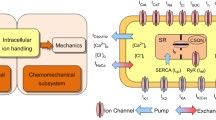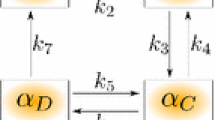Abstract
We have developed a simple mathematical model with three physiologically significant states to describe the changes in intrauterine pressure associated with a contraction during human parturition. The myometrium is modelled as a set of smooth muscle cells, each of which is in one of three states (quiescent, contracted, refractory) at a given time. These states are occupied according to a cycle governed by three temporal parameters. The solutions of the equations describing the model show an oscillatory behavior for particular values of these parameters, which is very similar to the time dependant development of intrauterine pressure during labor. Due to its non-linear terms, our model could lead to chaotic oscillations (in the mathematical sense), whose clinical counterpart may occur in cases of dystocia. Despite its simplicity, this model appears to be a useful guide to further investigations of the oscillatory behavior of the myometrium, or other smooth muscles, in normal and pathological situations.
Similar content being viewed by others
REFERENCES
Cabrol, D., E. Dallot, L. Cédard and C. Sureau (1985). Pregnancy related changes in the distribution of glycosaminoglycans in the cervix and corpus of the human uterus. European Journal of Obstetrics and Gynaecology and Reproductive Biology 20: 289–95.
Litime, M.H., G. Pointis, M. Breuiller, D. Cabrol and F. Ferré (1988). Disappearance of β-adrenergic response of human myometrial adenylate cyclase at the end of pregnancy. Journal of Clinical Endocrinology and Metabolism 69(1): 1–6.
Miyoshi, H. M.B. Boyle, L.B. McKay and R.E. Garfield (1996). Voltage clamp studies of gap junctions between uterine muscle cells during terma and preterm labor. Biophysical Journal 71: 1324–34.
Sakai, N., T. Tabb and R.E. Garfield (1993). Modulation of cell-to-cell coupling between myometrial cells of the human uterus during pregnancy. American Journal of Obstetrics and Gynecology 67(2): 472–80.
Sornette, D., B. Carbonne, F. Ferré, C. Vauge and E. Papiernik (1995). Modèle mathématique de la parturition humaine. Médecine/Sciences 8(11): 1150–53.
Young, R.C. (1997). A computer model of uterine contractions based on action potential propagation and intercellular calcium waves. Obstetrics and Gynecology 89(4): 604–8.
Wray, S. (1993). Uterine contraction and physiological mechanisms of modulation. American Journal of Physiology 264 (Cell Physiology 33): C1–C18.
Author information
Authors and Affiliations
Rights and permissions
About this article
Cite this article
Vauge, C., Carbonne, B., Papiernik, E. et al. A Mathematical Model of Uterine Dynamics and its Application to Human Parturition. Acta Biotheor 48, 95–105 (2000). https://doi.org/10.1023/A:1002728111528
Issue Date:
DOI: https://doi.org/10.1023/A:1002728111528




